AlcaicerĂa, Granada - A Historic Market of Moorish and Local Crafts

The AlcaicerĂa street is located next to the Cathedral, running from Plaza Alonso Cano to Ermita street. It is a commercial area full of small shops, mostly dedicated to the sale of souvenirs and handicrafts from Granada.

Enjoy a special day at the Alhambra with a guided tour
 Alhambra and Nasrid Palaces: discover the wonders of the Alhambra with this all-inclusive tour: the Nasrid Palaces, the Generalife, the Alcazaba, and more.
Alhambra and Nasrid Palaces: discover the wonders of the Alhambra with this all-inclusive tour: the Nasrid Palaces, the Generalife, the Alcazaba, and more.
 Alhambra + AlbaicĂn + Sacromonte: a perfect combination of a guided tour of the Alhambra in the morning and a guided tour of the Albaicin and Sacromonte in the afternoon.
Alhambra + AlbaicĂn + Sacromonte: a perfect combination of a guided tour of the Alhambra in the morning and a guided tour of the Albaicin and Sacromonte in the afternoon.The entire neighborhood of AlcaicerĂa was once an Arab marketplace but was almost completely destroyed in a fire in 1843. It was a closed and well-protected market, owned by the monarch after the Conquest, where raw silk was delivered to collect taxes and mark it.
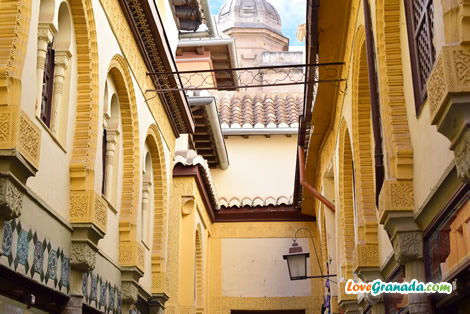 Additionally, high-priced merchandise such as silk, silver objects, goldsmith work, and sumptuous clothes were sold, with their
sale prohibited outside its confines.
Additionally, high-priced merchandise such as silk, silver objects, goldsmith work, and sumptuous clothes were sold, with their
sale prohibited outside its confines.
Why is it called La AlcaicerĂa?
Its name comes from the Arabic word 'al-qaysariya', which means a commercial institution.It is also said to be related to the name of Caesar, to whom the Arabs were grateful for allowing them to trade in silk.
A Glimpse into History
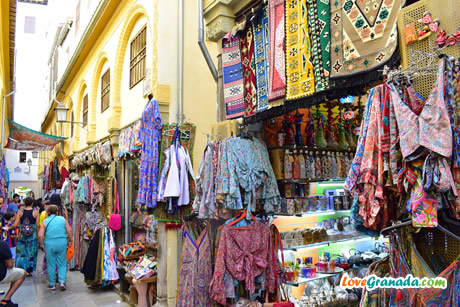 The AlcaicerĂa was founded in the 14th century next to the Great Mosque during the time of Muhammad V.
The AlcaicerĂa was founded in the 14th century next to the Great Mosque during the time of Muhammad V.
It was accessed through nine doors, which were closed at night to protect it.
It was a closed and well-protected marketplace owned by the monarch after the conquest, where taxes were collected, and high-priced goods were sold: silk, silverware, and sumptuous clothing, the sale of which was prohibited outside the market.
It was closed at night with solid doors, and only the warden and the guards remained inside. In the 16th century, it had almost 200 small shops.
 In the 17th century, significant changes took place, and all kinds of silk, woven and hank, gold, cloth,
linen, and other goods were sold in the AlcaicerĂa.
In the 17th century, significant changes took place, and all kinds of silk, woven and hank, gold, cloth,
linen, and other goods were sold in the AlcaicerĂa.
Its governor's guards watched over it with dogs at night, opened it during the daytime, and took care of its cleanliness.
At night, not only were all the establishments closed, but also the surrounding houses shut their doors with bars to prevent theft. The guard went on a thorough round, leaving only two of them inside, along with the warden and the dogs.
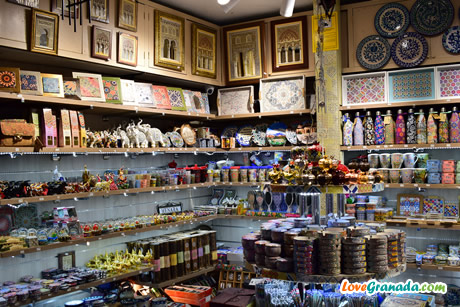 In the 18th century, the silk industry experienced a setback, and some shops were left unrented.
In the 18th century, the silk industry experienced a setback, and some shops were left unrented.
The enclosure was divided into two parts: one with the silk wholesale markets or shops, and the other with the jellies, customs, and their offices.
Thus, liners, scribes, and other shops unrelated to the art of silk were set up—an emblematic place that you will not forget.
Is La AlcaicerĂa just a street?
 La AlcaicerĂa is an area with gift shops and bazaars spread across three main streets,
which include both a shop and a street named "La AlcaicerĂa".
La AlcaicerĂa is an area with gift shops and bazaars spread across three main streets,
which include both a shop and a street named "La AlcaicerĂa".
The streets adjacent to the AlcaicerĂa that have craft shops are:
- AlcaicerĂa Street, the main street, starts at Bib Rambla.
- Ermita Street is home to numerous Arab and gift shops.
- Calle Oficios, near the cathedral, has only a few shops.
Shopping at La AlcaicerĂa
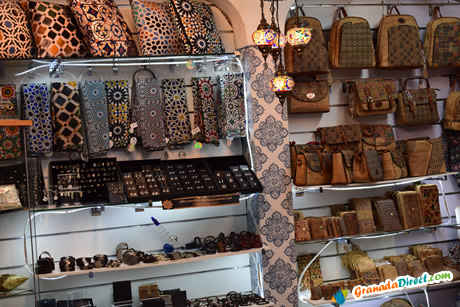 You’ll find a diverse range of products, artisanal goods and handmade crafts.The aromatic spices, colorful
ceramics, and intricate textiles will remind you of the famous Arab markets found throughout the Mediterranean
and North Africa.
You’ll find a diverse range of products, artisanal goods and handmade crafts.The aromatic spices, colorful
ceramics, and intricate textiles will remind you of the famous Arab markets found throughout the Mediterranean
and North Africa.
Many of the stalls are filled with beautiful souvenirs such as hand-painted pottery, leather goods, and flamenco dresses. But be prepared: like any traditional Arab market, the art of bargaining is very much alive here.
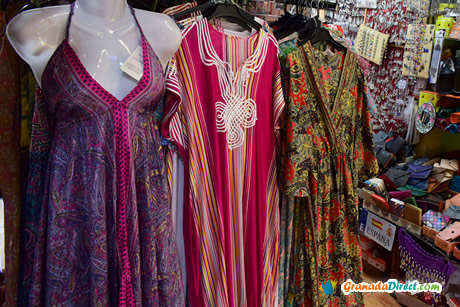 The vendors are friendly, but the prices can sometimes be a little inflated, so don’t be shy about negotiating.
Often, you can get a much better deal if you ask for a lower price—especially if you're buying multiple items.
The vendors are friendly, but the prices can sometimes be a little inflated, so don’t be shy about negotiating.
Often, you can get a much better deal if you ask for a lower price—especially if you're buying multiple items.
Whether you're looking for unique souvenirs like ceramic tiles, artisan jewelry, or a bottle of local olive oil, make sure to take your time and enjoy the experience of haggling for that perfect item.
Where to Eat Near the AlcaiceĂa?

Restaurant Oliver
Located in the heart of Granada, Restaurant Oliver is a classic that combines tradition and food. It’s known for its fresh fish dishes, like sea bass and garlic shrimp, as well as flavorful options such as salmorejo and artichokes with clams. The terrace is very pleasant, the staff is attentive, the value for money is hard to beat.Bar Aliatar
 Traditional tavern with over 70 years of history, known for its simple and tasty sandwiches. The place is small,
so it’s common to eat standing. Prices are very affordable, the staff is usually quick and efficient, and the
atmosphere is casual. It’s a spot frequented by both locals and visitors.
Traditional tavern with over 70 years of history, known for its simple and tasty sandwiches. The place is small,
so it’s common to eat standing. Prices are very affordable, the staff is usually quick and efficient, and the
atmosphere is casual. It’s a spot frequented by both locals and visitors.
Restaurant Más Que Vinos
Restaurant Más Que Vinos has two areas: one for tapas and another for meals. The tapas are simple but well done, including dishes like tempura eggplants and "huevos rotos", croquetas de setas and presa ibĂ©rica. The staff is attentive and friendly. There’s a good variety of wines. Both the dishes and drinks are presented with personalized touches.How to get to the AlcaicerĂa?
 The AlcaiceĂa is located in the historic center of Granada, next to the famous Bib Rambla square, the
Cathedral, and the Royal Chapel,
so it’s easy to reach on foot if you’re staying nearby.
The AlcaiceĂa is located in the historic center of Granada, next to the famous Bib Rambla square, the
Cathedral, and the Royal Chapel,
so it’s easy to reach on foot if you’re staying nearby.
If you prefer public transport, several bus lines stop just a few minutes from the market
You can reach the AlcaicerĂa by taking bus lines 4, 8, 11, 21, 33, C31, C32, C34, which go along Gran VĂa. The closest bus stop is the Cathedral, just a 1-minute walk from the market. Other nearby stops include Gran VĂa 1 and Recogidas, both about a 5-minute walk away.
hear your thoughts.
© Copyright •
LoveGranada.com • Any use of the content, including copying of it in whole or in part is prohibited.
You Might Also Be Interested In
Page Updated: Jul 17, 2025
Opinions about Alcaiceria in Granada
Fun to walk around
The nice open market is a maze of small, narrow streets filled with colorful stalls selling spices, lamps, silk, leather, ceramics, and other goods.
It's fun to walk around, simply look, and enjoy the atmosphere. However, the stalls tend to be quite repetitive, offering similar items.


